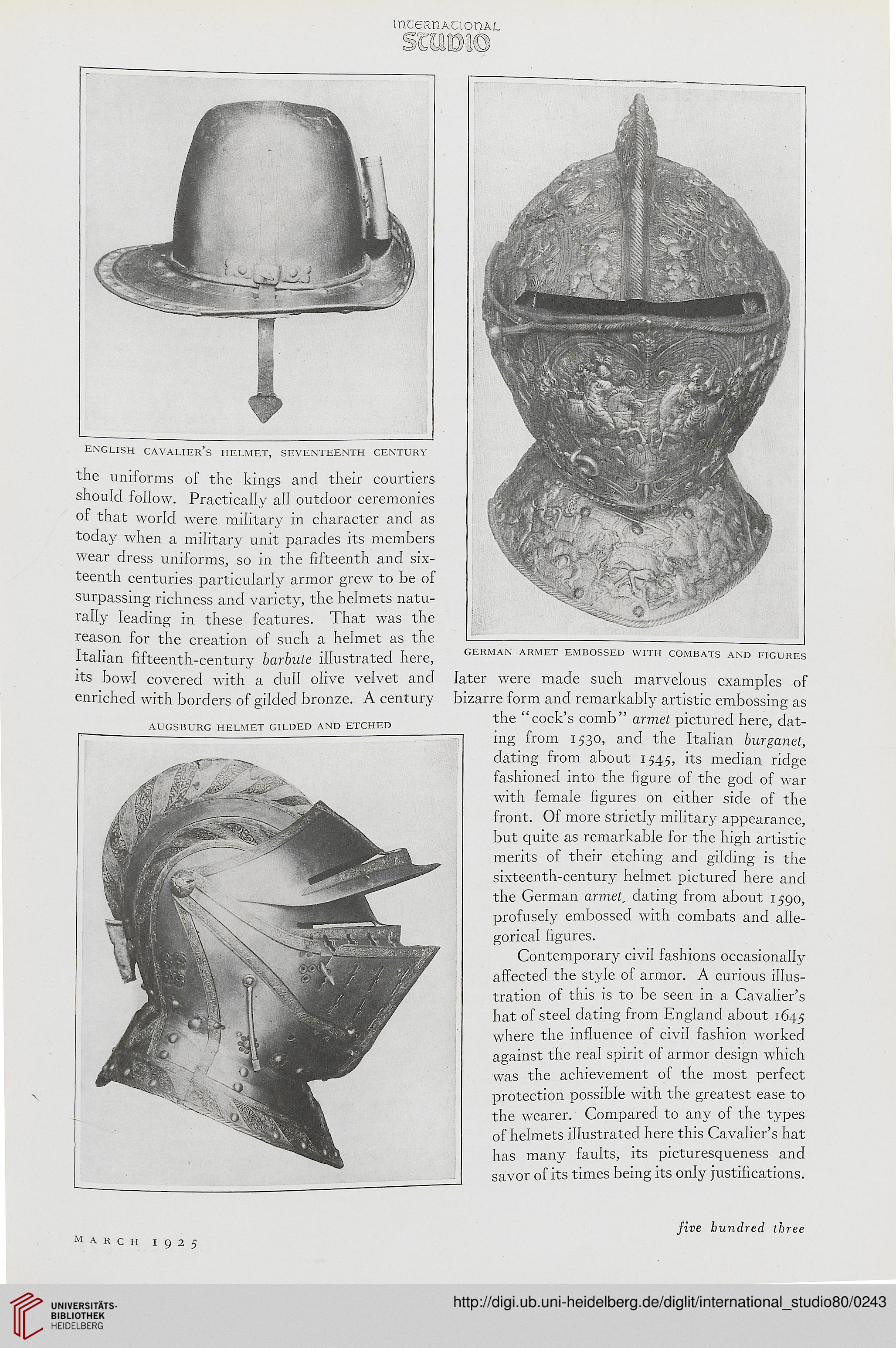mceRHAcionAL
german ahmet embossed with combats and figures
aucsburg helmet gilded and etched
english cavalier's helmet, seventeenth century
the uniforms of the kings and their courtiers
should follow. Practically all outdoor ceremonies
of that world were military in character and as
today when a military unit parades its members
wear dress uniforms, so in the fifteenth and six-
teenth centuries particularly armor grew to be of
surpassing richness and variety, the helmets natu-
rally leading in these features. That was the
reason for the creation of such a helmet as the
Italian fifteenth-century barbute illustrated here,
its bowl covered with a dull olive velvet and later were made such marvelous examples of
enriched with borders of gilded bronze. A century bizarre form and remarkably artistic embossing as
the "cock's comb" armet pictured here, dat-
ing from 1530, and the Italian burganet,
dating from about 1545, its median ridge
fashioned into the figure of the god of war
with female figures on either side of the
front. Of more strictly military appearance,
but quite as remarkable for the high artistic
merits of their etching and gilding is the
sixteenth-century helmet pictured here and
the German armet, dating from about 1590,
profusely embossed with combats and alle-
gorical figures.
Contemporary civil fashions occasionally
affected the style of armor. A curious illus-
tration of this is to be seen in a Cavalier's
hat of steel dating from England about 1645
where the influence of civil fashion worked
against the real spirit of armor design which
was the achievement of the most perfect
protection possible with the greatest ease to
the wearer. Compared to any of the types
of helmets illustrated here this Cavalier's hat
has many faults, its picturesqueness and
savor of its times being its only justifications.
march 1925
jive hundred three
german ahmet embossed with combats and figures
aucsburg helmet gilded and etched
english cavalier's helmet, seventeenth century
the uniforms of the kings and their courtiers
should follow. Practically all outdoor ceremonies
of that world were military in character and as
today when a military unit parades its members
wear dress uniforms, so in the fifteenth and six-
teenth centuries particularly armor grew to be of
surpassing richness and variety, the helmets natu-
rally leading in these features. That was the
reason for the creation of such a helmet as the
Italian fifteenth-century barbute illustrated here,
its bowl covered with a dull olive velvet and later were made such marvelous examples of
enriched with borders of gilded bronze. A century bizarre form and remarkably artistic embossing as
the "cock's comb" armet pictured here, dat-
ing from 1530, and the Italian burganet,
dating from about 1545, its median ridge
fashioned into the figure of the god of war
with female figures on either side of the
front. Of more strictly military appearance,
but quite as remarkable for the high artistic
merits of their etching and gilding is the
sixteenth-century helmet pictured here and
the German armet, dating from about 1590,
profusely embossed with combats and alle-
gorical figures.
Contemporary civil fashions occasionally
affected the style of armor. A curious illus-
tration of this is to be seen in a Cavalier's
hat of steel dating from England about 1645
where the influence of civil fashion worked
against the real spirit of armor design which
was the achievement of the most perfect
protection possible with the greatest ease to
the wearer. Compared to any of the types
of helmets illustrated here this Cavalier's hat
has many faults, its picturesqueness and
savor of its times being its only justifications.
march 1925
jive hundred three




